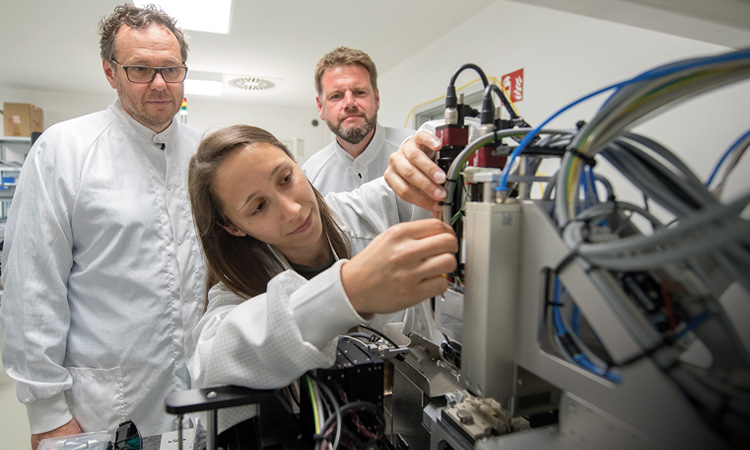 ficonTEC’s Chief Financial Officer Matthias Trinker (left) and CEO Torsten Vahrenkamp watch process engineer Janka Wöbbekind at work. [B. Hake / WESER-KURIER]
ficonTEC’s Chief Financial Officer Matthias Trinker (left) and CEO Torsten Vahrenkamp watch process engineer Janka Wöbbekind at work. [B. Hake / WESER-KURIER]
Optica, a professional home for optics and photonics researchers for more than 100 years, is continually looking for better ways to link up stakeholders across the industry. One example of this effort is the society’s industry summits—in-person gatherings that facilitate conversations between key players on cutting-edge topics in optics and photonics.
From 4 to 6 September, the latest Optica industry summit comes to Bremen, Germany. Hosted by ficonTEC, a global company that provides microassembly and testing solutions for the photonic-device industry, the Optica Photonic Devices Industry Summit will feature both executives and senior researchers from a variety of firms. They’ll speak in four sessions covering areas vital to the field—manufacturing and assembly technologies, industrial and medical applications, lidar and sensing, and communications.
The summit, Optica’s industry team says, aims at bringing corporate leaders together to improve their products and to make the world a better place. And, the team adds, the event highlights Optica as a resource for companies to get the information and people they need.
Exchanging ideas, inspiring solutions
The optics and photonics industry enables everything from high-speed communications to portable health care devices. However, despite its seemingly increasing importance, 85%–90% of companies in the field are relatively small, with revenues under US$10 million, according to Optica’s industry team.
A peek at the itinerary
As with others in the series, the Optica Photonic Devices Industry Summit starts with a welcome dinner that doubles as a networking event to help break the ice and encourage personal connections among attendees—a chance to get to know one another without delving too much into the technological nitty-gritty.
The second day kicks off with welcome remarks from Optica’s Chief Technology Officer Jose Pozo and ficonTEC’s Global Director Augusto Mandelli. There will also be a tour of the company’s laboratory in its headquarters in Achim, Germany, where attendees will get a glimpse into ficonTEC’s cutting-edge manufacturing process. The rest of day two and day three will feature talks from presenters and keynote speakers.
Optica’s Photonic Devices Industry Summit at ficonTEC is open to anyone but with a discounted rate for Optica Corporate Members. For more information about this and other industry opportunities, visit optica.org/industry/industry_events.
When those firms are asked what they need to do to grow, the answer often comes down to four tasks: become highly visible, forge connections, learn about the latest research and find good, qualified people to hire. Events such as the summit at ficonTEC, the industry team believes, can help companies meet those goals by gathering the field’s leaders in one room—especially valuable after several years of lost in-person opportunities during the COVID-19 pandemic.
The ficonTEC summit will feature talks from people at the forefront of the field. One such speaker is David Bitauld, who leads the advanced photonic integration research department at III–V Lab.
Bitauld—who describes his department’s work as “everything related to the design and characterization of photonic components for telecommunication applications”—will talk about various platforms for transmitters for photonic telecommunications, including one in which III–V materials are grown on an InP substrate and another based on the heterointegration of III–V material on silicon substrates. Such approaches, Bitauld says, will allow the transmitters to manipulate light while keeping their compact size.
Another speaker is Mary Johnson, the CEO of Wavelength Electronics, a US-based manufacturer of laser electronics that specializes in precise laser-diode control. She plans to talk about the company’s previous collaborations that turned out to be successful—from licensing technology for quantum cascade lasers to working in labs with customers to see their operations in action and catch where the electronics might be contributing to noise.
Johnson says she’s looking forward to connecting with potential customers in Europe. She also thinks the summit’s wide range of topics will benefit a manufacturer and solutions provider like Wavelength, as hearing about different applications will help Johnson brainstorm other markets the firm could explore with its technologies.
Similarly, Bitauld thinks exchanging thoughts with his peers and learning how people working on other applications solved their problems could inspire solutions for the communications field. The summit will also present “what kind of ideas people have, [what] directions different markets are taking and where [III–V Lab] could contribute,” he adds.
Looking ahead
Optica’s industry team is prepared to treat summit participants like the “rock stars” that they are.
So where are photonic devices headed? Bitauld thinks the field is moving toward denser integration on chip for better functionality. “The challenge is to fit all of these things that may have different requirements, all together at the lowest possible cost.” Johnson also sees integration as a defining feature for the future. “I was very excited to see the photonics layer getting integrated into a circuit board,” she says. “So I’m very curious to know how we can use those kinds of circuit boards and expand even further.”
Optica’s industry team says it is prepared to treat summit participants like the “rock stars” that they are. At the same time, team members are already looking for “hot, upcoming” topics for their next events, for the best possible support of Optica’s corporate members.
Karen Kwon is OPN’s associate editor.

